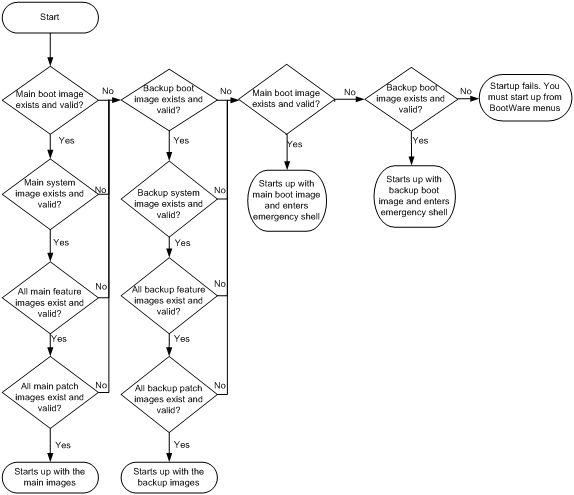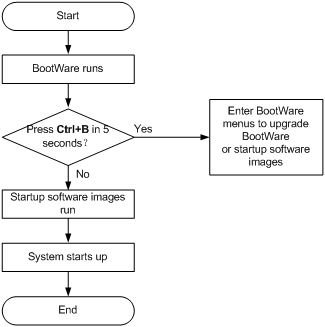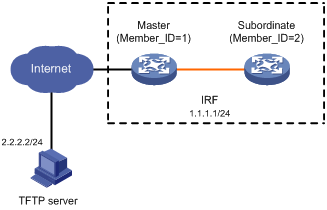- Table of Contents
-
- 01-Fundamentals Configuration Guide
- 00-Preface
- 01-CLI configuration
- 02-RBAC configuration
- 03-Login management configuration
- 04-FTP and TFTP configuration
- 05-File system management configuration
- 06-Configuration file management configuration
- 07-Software upgrade configuration
- 08-ISSU configuration
- 09-Emergency shell configuration
- 10-Automatic configuration
- 11-Device management configuration
- 12-Security zone configuration
- 13-Tcl configuration
- 14-Python configuration
- 15-Management with BootWare
- 16-License management
- Related Documents
-
| Title | Size | Download |
|---|---|---|
| 07-Software upgrade configuration | 173.80 KB |
Software file naming conventions
Comware image redundancy and loading procedure
Upgrade restrictions and guidelines
Specifying startup images and completing the upgrade
Enabling software synchronization from the active MPU to the standby MPU at startup
Displaying and maintaining software image settings
Software upgrade example (in standalone mode)
Upgrading software
Overview
Software upgrade enables you to add new features and fix bugs. This chapter describes types of software and methods to upgrade software from the CLI. For a comparison of all software upgrade methods, see "Upgrade methods."
When you upgrade software, you do not need to upgrade interface cards separately. The software images are integrated for MPUs and interface cards. The interface cards upgrade automatically when you upgrade MPUs.
Software types
The following software types are available:
· BootWare image—A .bin file that contains a basic segment and an extended segment. The basic segment is the minimum code that bootstraps the system. The extended segment enables hardware initialization and provides system management menus. You can use these menus to load software and the startup configuration file or manage files when the device cannot start up correctly.
· Comware image—Includes the following image subcategories:
¡ Boot image—A .bin file that contains the Linux operating system kernel. It provides process management, memory management, file system management, and the emergency shell.
¡ System image—A .bin file that contains the minimum feature modules required for device operation and some basic features, including device management, interface management, configuration management, and routing. To have advanced features, you must purchase feature images.
¡ Feature image—A .bin file that contains advanced software features. Users purchase feature images as needed.
¡ Patch image—A .bin file irregularly released for fixing bugs without rebooting the device. A patch image does not add new features or functions.
Comware images that have been loaded are called current software images. Comware images specified to load at the next startup are called startup software images.
BootWare image, boot image, and system image are required for the system to operate. These images might be released separately or as a whole in one .ipe package file. If an .ipe file is used, the system decompresses the file automatically, loads the .bin images and sets them as startup software images. Typically, the BootWare and startup software images for the device are released in an .ipe file named main.ipe.
Software file naming conventions
Software image file names use the chassis-comware version-image type-release format. This document uses boot.bin and system.bin as boot and system image file names.
Comware image redundancy and loading procedure
You can specify two lists of Comware software images: one main and one backup.
The system always attempts to start up with the main images. If any main image does not exist or is invalid, the system tries the backup images. Figure 1 shows the entire Comware image loading procedure.
In this procedure, both the main and backup image lists have feature and patch images. If an image list does not have feature or patch images, the system starts up with the boot and system images after they pass verification.
If both the main and backup boot images are nonexistent or invalid, access the BootWare menu during the system startup to upgrade software.
After accessing the emergency shell, connect to the console port and load a system image so you can access the Comware system. For more information about using the emergency shell, see "Using the emergency shell."
Figure 1 Comware image loading procedure

System startup process
Upon power-on, the BootWare image runs to initialize hardware, and then the startup software images run to start up the entire system, as shown in Figure 2.
Figure 2 System startup process

Upgrade methods
|
Upgrading method |
Software types |
Remarks |
|
Upgrading from the CLI by using the boot-loader file command |
· BootWare image · Comware images (excluding patches) |
This method is disruptive. You must reboot the entire device to complete the upgrade. |
|
Performing an ISSU |
Comware images |
The ISSU method enables a software upgrade without service interruption. Use this method for an IRF fabric or MPU-redundant device. For more information about ISSU, see "Performing an ISSU." |
|
Upgrading from the BootWare menu |
· BootWare image · Comware software images |
Use this method when the device cannot start up correctly. To use this method, first connect to the console port and power cycle the device. Then, press Ctrl+B at prompt to access the BootWare menu. For more information about upgrading software from the BootWare menu, see the release notes for the software version.
Upgrade an IRF fabric from the CLI instead of the BootWare menu, if possible. The BootWare menu method increases the service downtime. It requires that you upgrade the member devices one by one. |
This chapter only covers upgrading software from the CLI by using the boot-loader file command.
Upgrade restrictions and guidelines
The device starts up from the default file system. For SR6600 routers, the default file system can be the built-in flash memory (factory default) or a USB disk. For SR6600-X routers, the default file system can be the built-in CF card (factory default) or a USB disk. To change the default file system setting, access the BootWare menu. For more information, see the release notes for the device.
As a best practice, store the startup images in the factory-default file system.
If the device is starting up from a USB disk, do not remove the USB disk during startup.
The device starts up from the default file system. The default file system can be the built-in flash memory (factory default) or a CF card. To change the default file system setting, access the BootWare menu. For more information, see the release notes for the device.
As a best practice, store the startup images in the factory-default file system.
If the device is starting up from a CF card, do not remove the CF card during startup.
Preparing for the upgrade
1. Use the display version command to verify the current BootWare image version and startup software version.
2. Use the release notes for the upgrade software version to evaluate the upgrade impact on your network and verify the following items:
¡ Software and hardware compatibility.
¡ Version and size of the upgrade software.
¡ Compatibility of the upgrade software with the current BootWare image and startup software image.
3. Use the release notes to verify whether the software images require a license. If licenses are required, register and activate licenses for each license-based software image. For more information about licensing, see "Managing licenses."
4. Use the dir command to verify that each MPU has sufficient storage space for the upgrade images. If the storage space is not sufficient, delete unused files by using the delete command. For more information, see "Managing file systems."
5. Use FTP or TFTP to transfer the upgrade image file to the root directory of a file system.
For more information about FTP and TFTP, see "Configuring FTP" or "Configuring TFTP."
Upgrade task list
|
Tasks at a glance |
Remarks |
|
(Required.) Specifying startup images and completing the upgrade |
N/A |
|
(Optional.) Enabling software synchronization from the active MPU to the standby MPU at startup |
By default, software synchronization is enabled. This feature enables automatic software synchronization when the device operates in standalone mode. With software synchronization, you do not need to manually upgrade the standby MPU. To synchronize software from the global active MPU to other MPUs on an IRF fabric, use the irf auto-update enable command. |
Specifying startup images and completing the upgrade
In standalone mode
Perform this task in user view.
To specify the startup image file and complete the upgrade:
|
Step |
Command |
Remarks |
|
1. Specify main or backup startup images for the active MPU. |
· Use an .ipe file for upgrade: · Use .bin files for upgrade: |
Upgrade files must be saved in the root directory of a file system on the active MPU. To avoid configuration failure, make sure no other users are configuring or managing the device. |
|
1. Specify main or backup startup images for the standby MPU. |
· Method 1 Use an .ipe file for upgrade: · Method 1 Use .bin files for upgrade: · Method 2: · Method 3: |
When you use method 2, make sure you understand the following requirements and upgrade results: · If a patch installation or ISSU has been performed, use the install commit command to update the main startup images on the active MPU before software synchronization. The command ensures startup image consistency between the active MPU and the standby MPU. · If the active MPU started up with main startup images, its main startup images are synchronized to the standby MPU. This synchronization occurs regardless of whether any change has occurred to this set of startup images. · If the active MPU started up with backup startup images, its backup startup images are synchronized to the standby MPU. This synchronization occurs regardless of whether any change has occurred to this set of startup images. · Startup image synchronization will fail if any software image being synchronized is corrupted or is not available. To avoid configuration failure, make sure no other users are configuring or managing the device. |
|
2. Save the running configuration. |
save |
This step ensures that any configuration you have made can survive a reboot. |
|
3. Reboot the device. |
reboot |
At startup, the MPUs load the startup images. |
|
4. (Optional.) Verify the software image settings. |
display boot-loader [ slot slot-number ] |
Verify that the current software images are the same as the startup software images. |
In IRF mode
Perform this task in user view.
To specify the startup image file and complete the upgrade:
|
Step |
Command |
Remarks |
|
1. Specify main or backup startup images for the global active MPU. |
· Use an .ipe file for upgrade: · Use .bin files for upgrade: |
Upgrade files must be saved in the root directory of a file system on the global active MPU. To avoid configuration failure, make sure no other users are configuring or managing the device. |
|
2. Specify the main startup images for each standby MPU in the IRF fabric. |
· Method 1 Use an .ipe file for upgrade: · Method 1 Use .bin files for upgrade: · Method 2: |
Skip this step if you have only one single-MPU device. When you use the boot-loader update command, make sure you understand the following requirements and upgrade results: · If a patch installation or ISSU has been performed, use the install commit command to update the main startup images on the active MPU before software synchronization. The command ensures startup image consistency between the active MPU and the standby MPU. · The boot-loader update command uses the main or backup startup image list for synchronization, instead of the current software images list. ¡ The main images list is used if the global active MPU started up with the main startup images. ¡ The backup image list is used if the global active MPU started up with the backup startup images. Startup image synchronization will fail if any software image being synchronized is corrupted or is not available. To avoid configuration failure, make sure no other users are configuring or managing the device. |
|
3. Save the running configuration. |
save |
This step ensures that any configuration you have made can survive a reboot. |
|
4. Reboot the IRF fabric. |
reboot |
At startup, the MPUs load the startup images. |
|
5. (Optional.) Verify the software image settings. |
display boot-loader [ chassis chassis-number [ slot slot-number ] ] |
Verify that the current software images are the same as the startup software images. |
Enabling software synchronization from the active MPU to the standby MPU at startup
This feature is available only when the device is operating in standalone mode. To synchronize software from the global active MPU to other MPUs on an IRF fabric, use the irf auto-update enable command. For more information about software auto-update, see Virtual Technologies Configuration Guide.
When the standby MPU starts up, this feature examines its startup software images for version inconsistency with the current software images on the active MPU.
If the software versions are different, the standby MPU performs the following operations:
1. Copies the current software images of the active MPU.
2. Specifies the images as startup software images.
3. Reboots with these images.
|
|
IMPORTANT: To ensure a successful synchronization in a multiuser environment, prevent users from rebooting or swapping MPUs during the software synchronization process. You can configure the information center to output the synchronization status to configuration terminals (see Network Management and Monitoring Configuration Guide). |
To enable software synchronization from the active MPU to the standby MPU at startup:
|
Step |
Command |
Remarks |
|
1. Enter system view. |
system-view |
N/A |
|
2. Enable startup software version check for the standby MPU. |
undo version check ignore |
By default, startup software version check is enabled. |
|
3. Enable software auto-update for the standby MPU. |
version auto-update enable |
By default, software version auto-update is enabled. |
Displaying and maintaining software image settings
Execute display commands in any view.
|
Task |
Command |
|
Display current software images and startup software images (in standalone mode). |
display boot-loader [ slot slot-number ] |
|
Display current software images and startup software images (in IRF mode). |
display boot-loader [ chassis chassis-number slot slot-number ] |
Software upgrade example (in standalone mode)
Network requirements
As shown in Figure 3, the device has two MPUs: one active MPU in slot 0 and one standby MPU in slot 1.
Use the file startup-a2105.ipe to upgrade software images for the device.

Configuration procedure
# Configure IP addresses and routes. Make sure the device and the TFTP server can reach each other. (Details not shown.)
# Configure TFTP settings on both the device and the TFTP server. (Details not shown.)
# Display information about the current software images.
<Sysname> display version
# Back up the current software images.
<Sysname> copy boot.bin boot_backup.bin
<Sysname> copy system.bin system_backup.bin
# Specify boot_backup.bin and system_backup.bin as the backup startup image files for both MPUs.
<Sysname> boot-loader file boot cfa0:/boot_backup.bin system cfa0:/system_backup.bin slot 0 backup
<Sysname> boot-loader file boot cfa0:/boot_backup.bin system cfa0:/system_backup.bin slot 1 backup
# Use TFTP to download the image file startup-a2105.ipe from the TFTP server to the root directory of the file system on the active MPU.
<Sysname> tftp 2.2.2.2 get startup-a2105.ipe
# Specify startup-a2105.ipe as the main startup image file for both MPUs.
<Sysname> boot-loader file cfa0:/startup-a2105.ipe slot 0 main
<Sysname> boot-loader file cfa0:/startup-a2105.ipe slot 1 main
# Verify the startup image settings.
<Sysname> display boot-loader
# Reboot the device to complete the upgrade.
<Sysname> reboot
# Verify that the device is running the correct software.
<Sysname> display version
Software upgrade example (in IRF mode)
Network requirements
As shown in Figure 4, use the file startup-a2105.ipe to upgrade software images for the IRF fabric.
Each IRF member device has two MPUs: one in slot 0 and one in slot 1. The global active MPU is in slot 0 on the master device.

Configuration procedure
# Configure IP addresses and routes. Make sure the device and the TFTP server can reach each other. (Details not shown.)
# Configure TFTP settings on both the device and the TFTP server. (Details not shown.)
# Display information about the current software images.
<Sysname> display version
# Back up the current software images.
<Sysname> copy boot.bin boot_backup.bin
<Sysname> copy system.bin system_backup.bin
# Specify boot_backup.bin and system_backup.bin as the backup startup image files for all MPUs.
<Sysname> boot-loader file boot cfa0:/boot_backup.bin system cfa0:/system_backup.bin chassis 1 slot 0 backup
<Sysname> boot-loader file boot cfa0:/boot_backup.bin system cfa0:/system_backup.bin chassis 1 slot 1 backup
<Sysname> boot-loader file boot cfa0:/boot_backup.bin system cfa0:/system_backup.bin chassis 2 slot 0 backup
<Sysname> boot-loader file boot cfa0:/boot_backup.bin system cfa0:/system_backup.bin chassis 2 slot 1 backup
# Use TFTP to download the image file startup-a2105.ipe from the TFTP server to the root directory of the flash memory on the global active MPU.
<Sysname> tftp 2.2.2.2 get startup-a2105.ipe
# Specify startup-a2105.ipe as the main startup image file for all MPUs.
<Sysname> boot-loader file cfa0:/startup-a2105.ipe chassis 1 slot 0 main
<Sysname> boot-loader file cfa0:/startup-a2105.ipe chassis 1 slot 1 main
<Sysname> boot-loader file cfa0:/startup-a2105.ipe chassis 2 slot 0 main
<Sysname> boot-loader file cfa0:/startup-a2105.ipe chassis 2 slot 1 main
# Verify the startup image settings.
<Sysname> display boot-loader
# Reboot the IRF fabric to complete the upgrade.
<Sysname> reboot
# Verify that the IRF fabric is running the correct software.
<Sysname> display version

